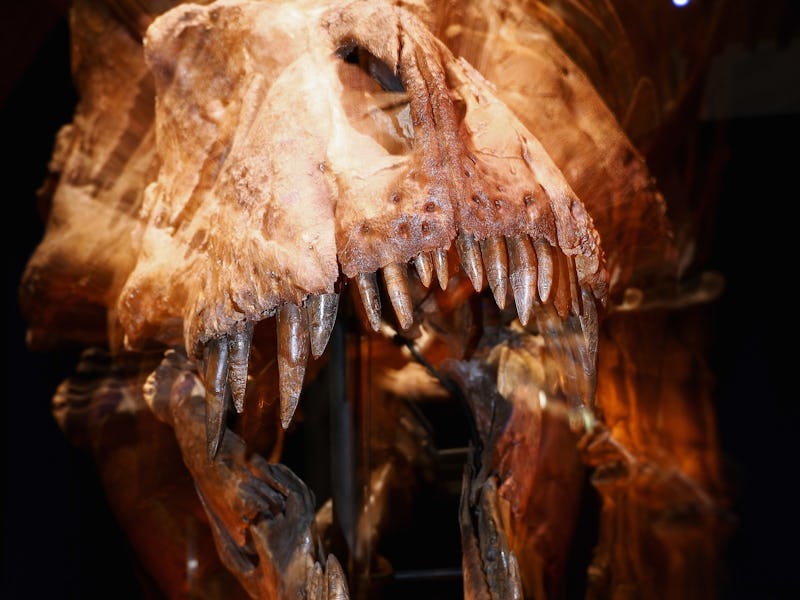T. Rex's Railroad Spike Teeth Were a Pulverizing Machine
It was a lethal way to deliver nutrients.

“Just about everything you see in Jurassic Park is a misconception,” Gregory Erickson says. “The T. rex wasn’t that big, fast, or look like that.”
Even so, the T-rex was still quite formidable, and research published Wednesday in Scientific Reports shows that the reptilian predator didn’t just use its teeth to impale the bodies’ of unwitting prey – it absolutely pulverized their thick, robust bones. This destructive ability opened up a rich source of nutrients (bone marrow and salts) for the T-rex, giving it an advantage over the other ravenous predators stalking the dinosaur-dense land, Erickson, a paleobiologist at Florida State University and a co-author of the study, argues.
“T-rex lived in a world with lots of big animals, and it was capable of getting more sustenance than its competitors,” he tells Inverse.
This important competitive advantage is evident today. Hyenas, renowned for their powerful bite, cannot break into elephant bones, which would provide them a bounty of nutrition-rich marrow.
What’s more, he says, teenage T. rexs put on an impressive five pounds of mass daily, so the animals certainly benefited from the ability to munch on the bones of prey.
The T. rex had an ample amount of jaw muscle.
To demonstrate T. rex’s bone chomping facility, Erickson employed the use of seven T. rex skulls, measuring both the actual fossils and casts, and putting one skull into a CT-scanner. The researchers fed this dino-data into a computer, enabling them to construct a 3D representation of the animal’s skulls and jaw bones. From here, the team found that the T. tex had a jaw-crushing power of 7,800 pounds (over twice that of today’s largest crocodiles – the living world-record holders) — for perspective, that’s equal to the weight of three small cars. When combined with the sturdy design of their teeth, this produced a whopping 431,000 pounds per square inch of pressure.
Erickson says that if you were to hold a T. rex tooth, you would find that it was blunt and robust, with a rounded cross-section and expands towards the bottom, giving it an ideal make-up for driving in cracks and destroying bone. “It’s like a railroad spike with steak-knife serrations,” explains Erickson.
This is an unprecedented and exceptional quality among reptiles. Crocodiles can throw a turtle into the back of their mouth and give it a good crunch, but unlike the T. rex, crocodiles can’t regularly break apart bones, lest they crack their more vulnerable, knife-like teeth.
In reality, the hulking Tyrannosaurus rex did more ambling around than chasing down and decapitating its prey, but its bone-annihilating ability – while perhaps not Hollywood-inspired – served this predator well. That is, until a rather large meteorite abruptly ended the dino king’s reign.
Abstract: Most carnivorous mammals can pulverize skeletal elements by generating tooth pressures between occluding teeth that exceed cortical bone shear strength, thereby permitting access to marrow and phosphatic salts. Conversely, carnivorous reptiles have non-occluding dentitions that engender negligible bone damage during feeding. As a result, most reptilian predators can only consume bones in their entirety. Nevertheless, North American tyrannosaurids, including the giant (13metres [m]) theropod dinosaur Tyrannosaurus rex stand out for habitually biting deeply into bones, pulverizing anddigesting them. How this mammal-like capacity was possible, absent dental occlusion, is unknown. Here we analyzed T. rex feeding behaviour from trace evidence, estimated bite forces and tooth pressures, and studied tooth-bone contacts to provide the answer. We show that bone pulverization was made possible through a combination of: (1) prodigious bite forces (8,526–34,522 newtons [N]) and tooth pressures (718–2,974 megapascals [MPa]) promoting crack propagation in bones, (2) tooth form and dental arcade configurations that concentrated shear stresses, and (3) repetitive, localized biting. Collectively, these capacities and behaviors allowed T. rex to finely fragment bones and more fully exploit large dinosaur carcasses for sustenance relative to competing carnivores.